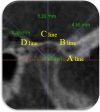Treatment effects of Herbst appliance in skeletal Class II cases during pre-pubertal and post-pubertal periods: a cone-beam computed tomographic study
- PMID: 37443323
- PMCID: PMC10344919
- DOI: 10.1038/s41598-023-37394-5
Treatment effects of Herbst appliance in skeletal Class II cases during pre-pubertal and post-pubertal periods: a cone-beam computed tomographic study
Abstract
In the present study, Thirty-six Class patients II (A condition in which the upper jaw is larger than the lower jaw) were randomly selected and assigned to one of two groups based on their maturation stage: the pre-pubertal group (18 patients, mean age 9.15 ± 1.5 years) and post-pubertal group (18 patients, mean age 16.3 ± 1.0 years). All patients were treated with a metallic splint-supported Herbst IV appliance (An appliance that acts like artificial joint working between the upper and power jaws that keeps the lower jaw in a forward position, thus improving the Class II condition). Pretreatment (T1) and post-Herbst IV treatment (T2) scans were obtained for both groups. Dental and skeletal measurements were made on the scans and statistically analyzed using paired and independent t-tests. The study hypothesis was that; the dentoskeletal changes in Class II malocclusion treatment using Herbst appliance in the Pre-pubertal is more than the Post-pubertal growth stage due to the remaining growth potential for the pre-pubertal patients. The comparison between the two groups revealed statistically significant differences in horizontal skeletal parameters in the lower jaw only, while other readings were similar.
© 2023. The Author(s).
Conflict of interest statement
The authors declare no competing interests.
Figures










Similar articles
-
Herbst appliance with skeletal anchorage versus dental anchorage in adolescents with Class II malocclusion: study protocol for a randomised controlled trial.Trials. 2017 Nov 25;18(1):564. doi: 10.1186/s13063-017-2297-5. Trials. 2017. PMID: 29178932 Free PMC article. Clinical Trial.
-
Maxillary molar distalization or mandibular enhancement: a cephalometric comparison of comprehensive orthodontic treatment including the pendulum and the Herbst appliances.Am J Orthod Dentofacial Orthop. 2003 Feb;123(2):108-16. doi: 10.1067/mod.2003.7. Am J Orthod Dentofacial Orthop. 2003. PMID: 12594414
-
Treatment effects of the edgewise Herbst appliance: a cephalometric and tomographic investigation.Am J Orthod Dentofacial Orthop. 2006 Nov;130(5):582-93. doi: 10.1016/j.ajodo.2005.01.030. Am J Orthod Dentofacial Orthop. 2006. PMID: 17110255
-
Dentoskeletal effects of Twin Block and Herbst appliances in patients with Class II division 1 mandibular retrognathy.Eur J Orthod. 2014 Apr;36(2):164-72. doi: 10.1093/ejo/cjt013. Epub 2013 Apr 24. Eur J Orthod. 2014. PMID: 24663007 Clinical Trial.
-
3D assessment of mandibular skeletal effects produced by the Herbst appliance.BMC Oral Health. 2020 Apr 16;20(1):117. doi: 10.1186/s12903-020-01108-4. BMC Oral Health. 2020. PMID: 32299402 Free PMC article.
Cited by
-
Oral Implications of Herbst Device Modification: A Case Report.Children (Basel). 2025 Apr 22;12(5):531. doi: 10.3390/children12050531. Children (Basel). 2025. PMID: 40426710 Free PMC article.
-
Assessment of the condylar response of two differently anchored fixed functional appliances in class II malocclusion in young adult orthodontic patients: A randomized clinical trial.J Orthod Sci. 2024 Feb 16;13:3. doi: 10.4103/jos.jos_112_23. eCollection 2024. J Orthod Sci. 2024. PMID: 38516116 Free PMC article.
References
-
- Baccetti T, Franchi L, Stahl F. Comparison of 2 comprehensive Class II treatment protocols including the bonded Herbst and headgear appliances: A double-blind study of consecutively treated patients at puberty. Am. J. Orthod. Dentofac. Orthop. 2009;135(6):698.e1–10. doi: 10.1016/j.ajodo.2008.03.015. - DOI - PubMed
Publication types
MeSH terms
LinkOut - more resources
Full Text Sources

